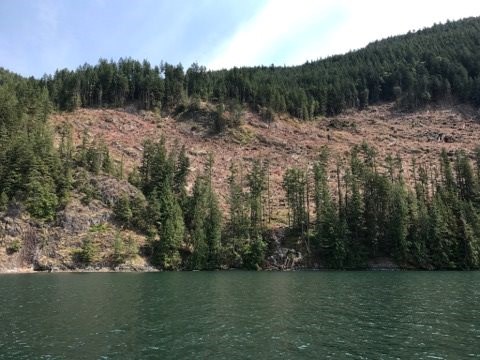In the spring of 2014, residents of Gambier Island pulled together to fight the creation of two woodlots comprising 1,326 hectares on the island’s northeast corner. In November of that year, the Ministry of Forests announced that it would delay the tendering process on those woodlots after the Gambier Island Conservancy launched an injunction asking a judge to halt the process. The Conservancy hired Bowen Islander John Rich as their lawyer, who says that legal actions were made more difficult by the lack of involvement Gambier residents had in the early stages of the consultation process.
“I was hired at the eleventh hour,” says Rich. “What became apparent very quickly once we got all the documents gathered by the Conservancy was that people on Gambier did not get involved in the process in a timely manner, and I think this is very relevant to Bowen. There had been a meeting roughly a year prior where a few people had turned up, but people didn’t realize this was their only shot at consultation from the perspective of the Ministry of Forests. From the perspective of BC Timber Sales, it was too late in the process for people to be objecting. That made the process of trying to get an injunction very difficult, BCTS had no legal obligation to do anything.”
Rich adds that in the end, the factors that brought about a halt to logging on Gambier are not relevant to the Bowen situation.
“It turns out that the Minister of Forests had previously made a promise to officials from Gambier that there would be more consultation, and in the end the government agreed to withhold issuance of the woodlot licences pending further consultation, which is what our injunction application had sought,” says Rich. “Looking to the consultation experience on Gambier, people on Bowen should be aware of the fact that Open Houses are cleverly designed to assist the proponent of a project. It is a very one-sided process. The proponent, being well prepared and seeking to advance the project, displays favourable material and deals with questions one on one, so that the public do not have the benefit of competing information.”
Islander Stephen Foster is currently working on lining-up support for a National Park Feasibility study on Gambier Island, and says that the experience of battling against these proposed woodlots seems to have challenged residents to hold serious discussions on the possibility of a park.
“Somehow Bowen Island seemed to inoculate itself against this threat for some time,” says Foster, who worked on the National Park proposal for Bowen in 2011. “When I was working on the park proposal here, I spoke with the chief forester for our district and he told me a decision had been made to keep Bowen as part of the district’s inventory and therefore eligible for logging at some point. I was told economics would be the deciding factor. However, when I brought this up at public meetings people opposed to the park labeled this information as fear tactics.”
On the stoppage of logging on Gambier, Foster points to the influence of the Squamish and Tsleil- Waututh Nations on the process.
“Both nations wrote strongly worded letters to the government stating their concerns about consultation, pointing out that proper process had not been followed,” says Foster. “This resulted in a statement from the Ministry calling for a pause in granting timber extraction on Gambier’s crown land. It is my understanding that the Gambier woodlots are back in play again, but this time, with the Squamish Nation at the table.”
Foster says that he sees collaboration between Bowen, Gambier and the Squamish Nation as critical to a positive outcome in the current logging bids.
“A unified vision for the future of Howe Sound is critical, and it is about drawing hard lines about what can, and cannot happen here,” says Foster. “This should be part of a larger collective effort, instead of the inevitable series of smaller individual battles. It is also critical to keep the lines of communication open with the Squamish Nation; it’s their territory after all.”



